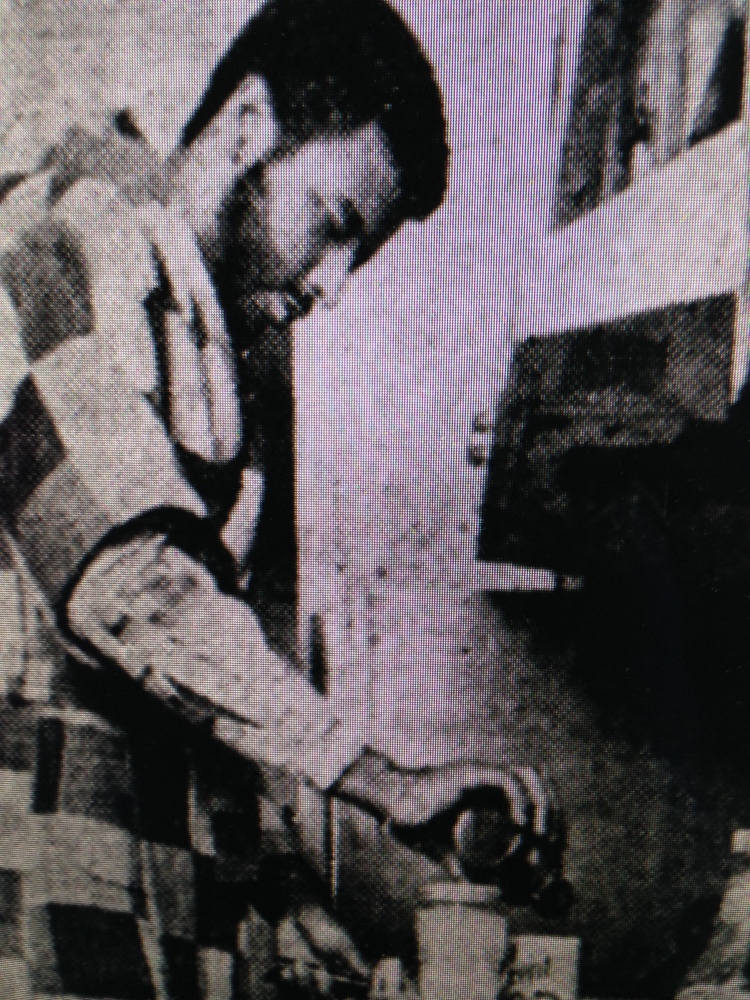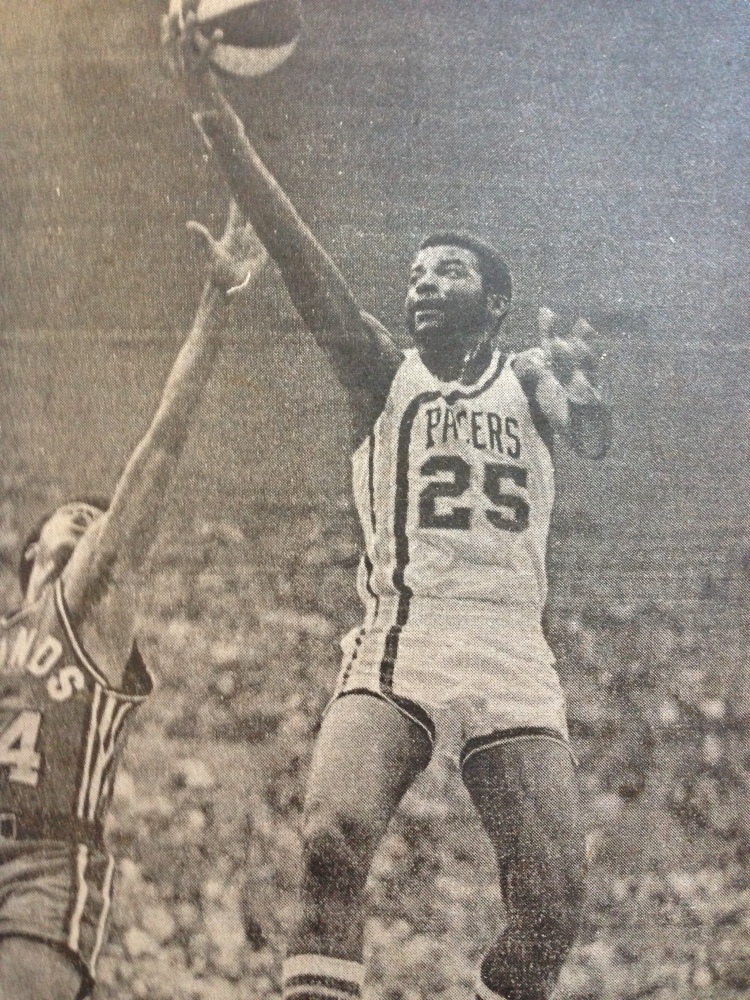[Billy Knight had an 11-season pro career, signing with the ABA Indiana Pacers in 1974. He weathered the uncertainty of NBA-ABA merger two seasons later to average 20-plus points a night for the NBA Pacers, then Buffalo—and then he hurt his knee. Knight rehabbed and remained a consistent scorer for the rest of his career. As one commentator snarked toward the end of Knight’s tried-and-true NBA run, “Starts with the constancy of a 12-year-old jalopy.”
Such snarkiness, however, was few and far between. Knight was always held in the highest esteem across the NBA. “There have never been any complaints about having Billy Knight around a ballclub,” wrote the Boston Globe’s Bob Ryan. “He could get along with Attila the Hun. Indeed, he is known around the NBA as one of the true “good guys.” That’s why after Knight retired, doors opened for him. He spent five seasons as the GM of the Atlanta Hawks, resigning in May 2008.
In this brief article, which ran in the April 1975 issue of Basketball Digest, the great Jim O’Brien, the ranking ABA reporter back then, profiles rookie Billy Knight. It’s a fun read about a not-so-fun, stay-in-his-hotel-room kid who just loves to play basketball.]
****
Billy Knight was nestled under several blankets in the bed of his hotel room on New York’s Long Island, near Nassau Coliseum where Knight’s team, the Indiana Pacers, would be playing the Nets the following evening. Knight was at ease, watching “Ironside” on TV. He said he’d call room service in a while for some sandwiches and soda pop. That’s Billy’s idea of a big night on the town.
He’s been seen leaving a Las Vegas casino around 10 p.m. to go to his room, a Coke in one hand, a slice of pizza in the other. So, acquaintances are not surprised by Billy’s behavior.

Knight’s best friend on the Pacers, superstar forward George McGinnis, had taken all his teammates into Manhattan earlier in the evening. They were going to a posh restaurant McGinnis had enjoyed during the summer and then to a Knicks’ game afterward at Madison Square Garden. McGinnis promised a bewitching evening, but Knight declined.
“I just didn’t feel like it,” Knight explained. “I told him I’d go the next time we’re in town.”
Knight said his teammates constantly kid him about his “bad habits.” It became a source of clubhouse humor with the Pacers, especially after Knight, an All-America at the University of Pittsburgh the previous season, got off to such a great start in the American Basketball Association.
The silky 6-foot-6 forward earned an early nickname, “Smooth,” and his smile, easy-going nature, and seldom-miss jump shot made him quite popular with the Pacers. In his first five games, Knight hit 33 of 47 shots—70 percent accuracy—and in one stretch made 12 straight shots.
“When I was making all my shots,” recalled Knight with a grin, “they’d go into restaurants and eat whatever I was eating, and wash it down with Cokes. But, before that, they were telling me that beer was better for me, that it didn’t have all that carbonated acid in it. But I just don’t like the taste of beer.”
McGinnis, shaking his head, offered, “That kid is going to have us all off beer and drinking Hi-C.”
Knight’s teammates got on him about something else, too. They admired his shot selection, but thought he was too conservative. They wanted him to shoot more. “They get mad at me for passing up shots,” said Knight. That’s unusual.
The No. 1 draft pick of the Pacers, Knight demonstrated early that he’d been a sound selection. The Pacers has some problems, but he wasn’t one of them. For one thing, the team owners got caught in a money squeeze, overextending themselves by purchasing a team in the World Hockey Association, spearheading a drive to build a new 18,000-seat downtown sports arena in Indianapolis, meeting McGinnis’ out-of-this-world contract demands, and being patient with a completely revamped Pacers’ ball team that lost a lot of games in the beginning.
During the previous summer, the Pacers’ management had traded away three fixtures in the team’s history—Mel Daniels, Freddie Lewis, and Roger Brown—as well as Donnie Freeman, who’d started for them the past two seasons, pledging themselves to building a new team around McGinnis. So, it was important for new players to come through, and Knight did not disappoint anybody.
Knight is a delightful young man, deadly with an open shot, who has been criticized because he played too passively and didn’t look like he was out to beat you. There were times he completely disappeared from the focal point of action. But by midseason, there was a definite improvement in the Pacers . . . and specifically in Knight.
The Pacers beat the Nets, defending ABA champs, three of their first four games. In the fifth game, Knight scored 13 of his 17 points in the second half and grabbed 15 rebounds. Every time the Nets threatened a comeback, Knight split the cords with a jump shot. You couldn’t have been any more competitive than Billy was that night.
It was only a year ago, in the spring, when he’d made a visit to New York to see Julius Erving, his hero, playing for the Nets. Knight had just completed his senior season, in which he averaged 21.8 points and 14 rebounds, while leading Pitt to 22 consecutive victories and a berth in the NCAA playoffs, where they ultimately lost in the East regional final to the eventual champion, North Carolina State.
Knight disclosed that he used to imitate Erving, better known as Dr. J., when he competed on the playgrounds or when the Pitt team was fooling around before practice sessions. “They all know Dr. J. is my man,” said Knight, “so if I did something fancy, or do a slam dunk on a tip in, they’ll shout, ‘Dr. J! Dr. J!’ I’ll smile. And I’ll give them a fist or something to acknowledge it.”
The Nets were playing the San Diego Conquistadors, then coached by Wilt Chamberlain, the night Billy came to see Dr. J. in action. Afterward, when he was introduced to Dr. J., they sat and chatted for a while. Erving showed Knight what a beating his knees have taken in a short time, and recommended that Knight wear protective pads on his knees. Knight promised that he would.

Knight also met Chamberlain. Wilt let him know he’d been aware of his presence during the game. Knight had been sitting in a front row seat straight across from Chamberlain. “I caught your act,” Chamberlain kidded him. “Every time Dr. J. did one of his dunks, you were jumping out of your seat.”
Knight smiled. “You dunked a few in your time, too,” he told Wilt.
“Yeah, but not with that kind of flourish,” said Chamberlain. “Look, I enjoy watching him myself. He’s something to see.”
Pro scouts had mixed reviews about Knight after his collegiate performance. “There’s a missing ingredient,” said one pro scout who’d seen Knight frequently when he played at Pitt. “He just seems to flow with the game. He seems to play the same if his team is up by eight points or down by eight points.”
Len Elmore of the University of Maryland, for instance, made a much more favorable impression on the pro people. Ironically enough, he’s now Knight’s teammate in Indiana and wasn’t getting to play much as the team’s No. 3 center the first half of this season.
Rod Thorn, assistant coach and chief scout for the Nets, was sold on Knight. He rated him the best “small” forward in the college ranks, naming Marvin Barnes of Providence as the best “big” forward. At midyear, Thorn looked right on both counts. “I don’t care what they say about Knight’s intensity,” Thorn said back then. “He’s going to be a player for someone, that’s for sure.”
Knight is only the second rookie in the Pacers’ history to crack the starting lineup right away. McGinnis was the first.
“Billy will be a great pro player for the next decade,” declares Pacers’ coach Bob Leonard. “There are not many veterans who have his composure, and the ability to do things so effortlessly. His future really is unlimited.”
Knight knew he’d have to make some adjustments when he entered the pros, and he’s proud that he’s made such rapid progress. “I think I’m a lot more loose now,” he said at the All-Star break. “At first, I was a little scared, a little tight and not as flexible. I was afraid to dribble behind my back or between my legs. But now, I can throw a few moves.
“The physical aspect was what bothered me, taking a beating day in and day out and playing with a lot of bumps and bruises. But now, it’s not as hard as I thought it would be. I was fortunate to play for a coach like Buzz Ridl [at Pitt], who stresses team play just like Bob Leonard. I don’t want to set any limits on myself, I just want to be as good as I can and help the team as much as I can.”
